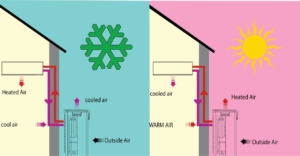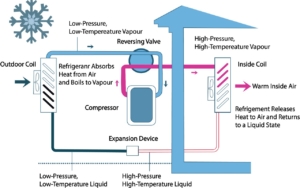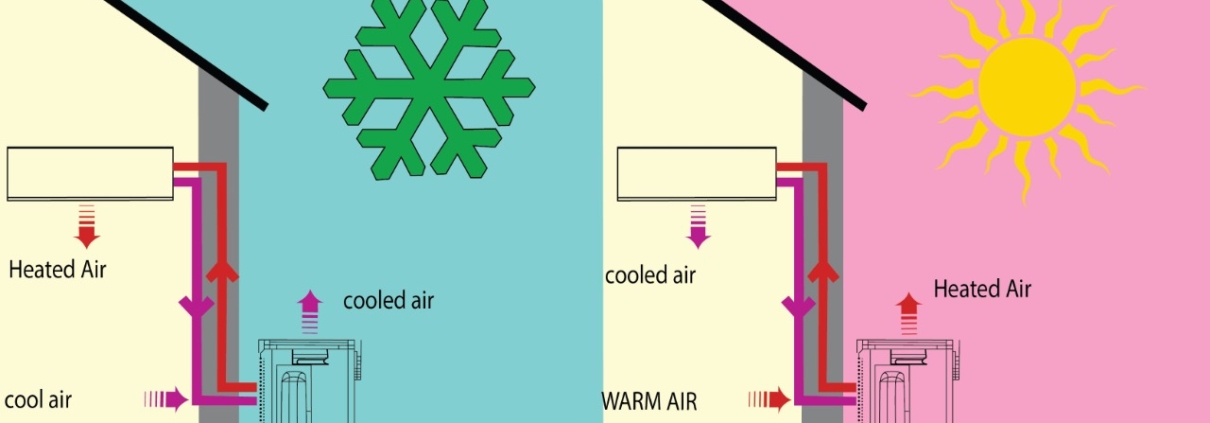Heat Pump Mini Splits
A heat pump mini-split system is also known as a “ductless heating and cooling system.” The name is such because these systems do not require any ductwork to be installed in your house. Commonly these systems are used for heating and cooling functions in a room or particular space.
Further, many people consider ductless mini-split heat pumps more effective than a central air conditioning system, as each system will be responsible for heating and cooling a particular zone. So instead of having the same temperature throughout the house, you could set different temperatures for different rooms. The mini-split systems are also more efficient than centralized air conditioning systems as they do not need ducts, and thus, the question of losing heating and cooling energy in the ductwork does not arise.
Ductless mini-split heat pumps have indoor units for handling air and outdoor units that function as compressors or condensers. Both these units are linked with a conduit containing a condensate drain, suction tubing, power cable, and refrigerant tubing.
A heat pump mini-split system has a very simple working mechanism, and we will discuss this at length. But before that, let’s take a moment to cover how these systems are different from traditional centralized air conditioning systems, mini-split costs, and why it may be worth having these systems in your home.
What is the Difference Between a Split System and a Mini Split?
The conventional central air systems or split systems and mini-splits both have two essential components, the external and internal units. Further, both are efficient in controlling the temperature in an indoor space. However, these have some major differences. One thing you already know is that mini-splits do not require ducts to function. Also, the conventional splits can only perform cooling, whereas the mini-splits can both cooling and heating.
Further, a centralized air conditioner will maintain the temperature of a space with its central thermostat. Mini-splits feature remote control which can easily maintain the temperature of mini-splits in different parts of your home.
Mini-splits are more energy efficient than conventional split systems thanks to their inverter technology and “ductless” feature. Moreover, mini-splits are easier to install, and they occupy less space than traditional split systems.
How Do Mini-Split Heat Pumps Work?
A heat pump mini-split system follows a step-by-step working mechanism. It has two functions, cooling, and heating.

How Mini-Splits Work for Indoor Cooling
- The process begins as the outdoor unit compresses refrigerant into a pressurized and high temperature liquid.
- The heat is transferred to the relatively cooler outdoor air. As the refrigerant becomes cooler it then passes through an expansion device which results in a significant reduction in pressure and temperature.
- This cold refrigerant travels to the indoor unit through the refrigeration lines.
- Next, the warmer indoor air is sucked by the air blower and becomes cool upon contact with the evaporator cooling coils. In this stage, excess humidity from the air is also removed.
- Meanwhile the refrigerant is transformed into a gaseous state as a result of absorbing heat from the indoor air.
- The refrigerant then returns to the outdoor unit.
- Finally, the compressor in the outdoor unit transforms the gas into high temperature liquid again through the exothermic process facilitated by the heat exchanger. This causes heat to be expelled from the refrigerant, which is why the outdoor units blow out hot air.
- Once the refrigerant cools, it is again sent back to the expansion device to repeat the cycle.
How Mini-Splits Work for Indoor Heating
As previously mentioned, mini-splits can both perform cooling and heating. Mini-splits have a reverse valve or special switch for heating an indoor space, making the flow of refrigerant reverse in this case.
- When in heating mode, the outdoor units absorb the heat from the outdoor atmosphere. The relatively warm outdoor air causes the refrigerant liquid to evaporate and turn into a gas.
- The gas is directed through a compressor, which causes the pressure to increase resulting in a high temperature gas.
- As the hot refrigerant travels inside, the blower in the indoor units makes the air flow over these warm coils, subsequently warming the surrounding air.
- As the gaseous refrigerant becomes cool, it is transformed into a liquid state again. When the refrigerant is returned to the outdoor unit, it passes through an expansion device which results in an even greater temperature drop.
- The refrigerant is warmed and vaporized by the outdoor air before entering the compressor again. Thus the cycle of heating continues.

Do Heat Pumps Work During the Winter?
Earlier versions of the heat pump dating back to the 80s and 90s worked well in moderate temperatures but struggled when temperatures dropped below freezing. Modern heat pumps, however, do not run into this issue. Heat pumps which are designed for colder climates can efficiently handle colder weather — even when the temperature is below 0 degrees Fahrenheit (-18 degrees Celsius). These cold climate heat pumps are capable of determining the minimum amount of energy needed to provide the desired level of heating and can adjust their output up or down, so that they never waste energy.
Should You Get a Mini-Split Heat Pump for Your Home?
The Department of Energy in the US underlines various advantages of getting mini-splits at homes. First of all, mini-splits offer flexible cooling in different rooms of a house. In many cases, four indoor units or heads placed in different rooms are connected to a single outdoor unit. Each of the heads will have its own thermostat for zone-specific cooling or heating. This flexibility of room-wise or zone-wise cooling and heating is also beneficial for saving energy and money. The Department of Energy further states that mini-splits can save up to 30% of energy consumption as they don’t need ducts.
An easy installation process is another advantage of getting mini-splits for your home. Moreover, these systems offer more flexibility in interior design as the indoor units can be wall-mounted or suspended from the ceiling. You will also find many floor-standing models of mini-split indoor units.
Having mentioned the benefits of mini-splits, these systems are ideal for specific types of homes. Mini-splits are great for cooling and HVAC care in older homes because installing a new duct system can be challenging in these homes. Further, homes with unique historical architecture should go for mini-splits as the HVAC systems. These systems are also suitable for home add-ons or extensions as they can condition the air of that specific space with an easy installation of a mini-split system. In simple words, if you choose mini-splits for home extensions, you will not need to redesign the entire HVAC system of your home.
Moreover, mini-splits are ideal for homes where renovation for installing ducts can be challenging and expensive.
How Much Does it Cost to Install a Mini Split Heat Pump?
The cost of a split system heat pump will depend on a lot of things. The first factor is the number of indoor units or heads you need for a mini-split system. It is possible to get multiple heads installed in multiple rooms of your house, and all the heads can be connected to a single outdoor unit. On average, every additional head will cost you something between $700 and $2300, covering the price of the unit and installation charges.
Another factor determining the cost of mini-split installation is the brand you choose. Also, the efficiency or the Seasonal energy efficiency ratio (SEER) score will impact the cost of a unit. A unit with a higher SEER will cost you more, but it is ideal if you want to pay lower electricity bills. In addition, the number of BTU or British Thermal Units needed for your space will determine the cost of your mini-split. Finally, your location and difficulties in the installation will be a vital factor in how much money you need to pay.
Nevertheless, installing a mini-split in your home will likely cost between $5000 and $18500.
Final Words:
In summary, mini-split systems have similar engineering to the traditional split systems used in home HVAC setups. However, they can perform cooling and heating both and offer more flexibility with zone-specific cooling or heating. Further, being more energy-efficient, these systems can be cost-saving solutions for all homeowners in the long run.
Mini-splits are expensive and need professional installation for proper functioning. So, you should consult a home or HVAC contractor near you to choose the right mini-split system and proper installation.




